Top 30 Construction Checklists (Download Free)

Ensuring safety on a construction site is no easy task. With so many hazards, having a structured approach is crucial. A construction checklist is your best ally. It helps keep your team safe and your project compliant. From daily inspections to specialized checks, these lists cover all aspects of site safety.
Using a construction checklist ensures no detail is overlooked. It keeps everyone accountable and aware of potential hazards. Regular inspections can prevent accidents and ensure OSHA compliance.
Empower your team with the right tools and knowledge. Here’s our list of top 10 construction checklists that can be downloaded free:
The top 10 OSHA Inspection Checklists:
1. Workplace Safety Inspection Checklist
2. Construction HSE Inspection Checklist
3. Construction Site Inspection Checklist
4. OSHA Construction Safety Inspection Checklist
5. Construction Punch List Checklist
7. Observation Inspection Checklist
8. OSHA Self Inspection Checklist
9. Incoming Inspection Checklist
10. Take 5 Safety Inspection Checklist
11. Floor Inspection Checklist
12. Site Safety Inspection Checklist
13. OSHA Electrical Safety Inspection Checklist
14. OSHA Fall Protection Inspection Checklist
15. OSHA Forklift Safety Inspection Checklist
16. OSHA General Safety Inspection Checklist
17. OSHA PPE Inspection Checklist
18. OSHA Hazard Communication Inspection Checklist
19. OSHA LOTO Inspection Checklist
20. Fire Safety Inspection Checklist
21. Health and Safety Inspection Checklist
23. Supplier Verification Inspection Checklist
24. Daily Safety Inspection Checklist
25. Ladder Inspection Checklist
29. Project Closeout Checklist
30. Pre-Startup Safety Review (PSSR) Checklist
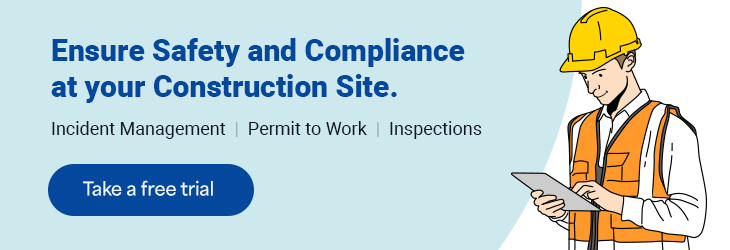
1. Workplace Safety Inspection Checklist
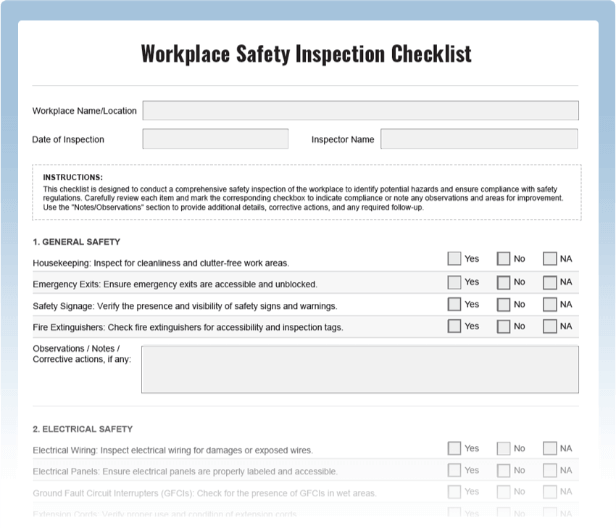
What it Ensures:
This checklist ensures that general workplace safety practices are followed on-site to maintain a safe working environment.
How it Can Help:
It helps identify potential hazards early, ensuring timely corrective actions to prevent accidents.
2. Construction HSE Inspection Checklist
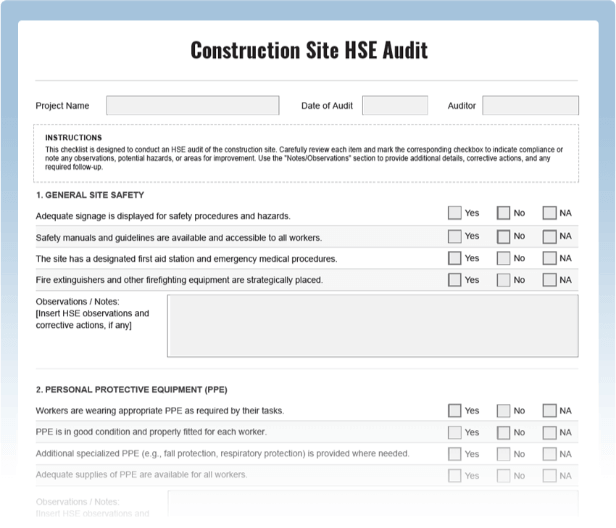
What it Ensures:
Ensures comprehensive health, safety, and environmental checks specific to construction sites.
How it Can Help:
Helps maintain compliance with HSE standards and reduces risks of environmental hazards.
3. Construction Site Inspection Checklist
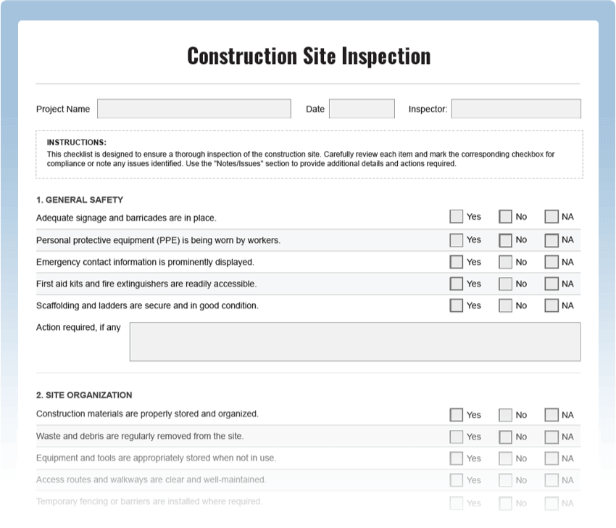
What it Ensures:
Ensures detailed site inspections covering various safety aspects.
How it Can Help:
Identifies potential safety issues before they become serious problems.
4. OSHA Construction Safety Inspection Checklist

What it Ensures:
Ensures compliance with OSHA standards for construction safety.
How it Can Help:
Helps avoid fines and improves overall site safety by adhering to regulatory requirements.
5. Construction Punch List Checklist
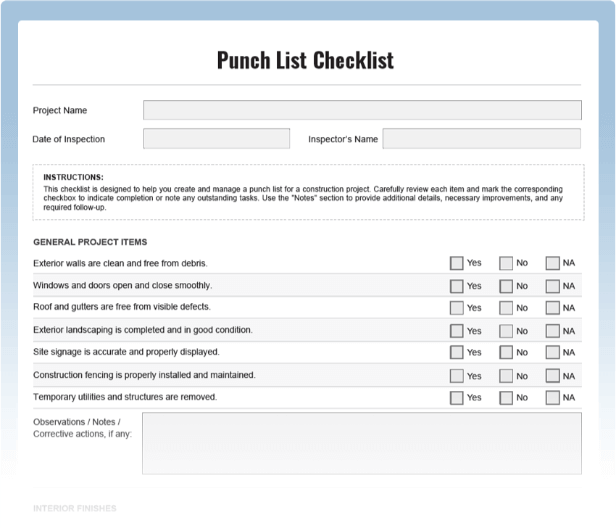
What it Ensures:
Ensures all tasks are completed before project handover.
How it Can Help:
Provides a clear, organized list of tasks that need to be addressed before the project is considered complete.
6. PPE Compliance Checklist
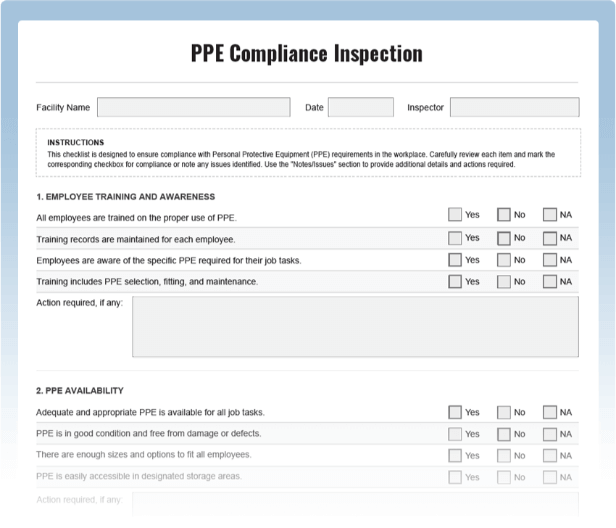
What it Ensures:
Ensures proper use and maintenance of personal protective equipment.
How it Can Help:
Protects workers from potential injuries by ensuring PPE is in good condition and used correctly.
7. Observation Inspection Checklist
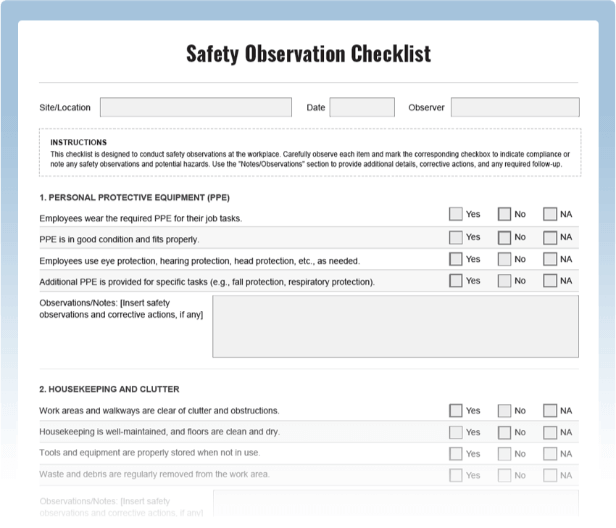
What it Ensures:
Ensures regular observations to identify unsafe behaviors and conditions.
How it Can Help:
Promotes a culture of safety by addressing issues as they arise.
8. OSHA Self Inspection Checklist
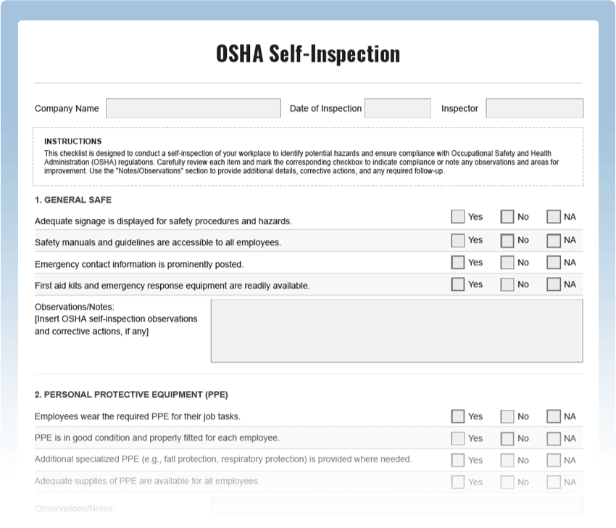
What it Ensures:
Ensures internal audits to maintain ongoing compliance with OSHA standards.
How it Can Help:
Helps in early detection of non-compliance issues, reducing the risk of accidents and penalties.
9. Incoming Inspection Checklist
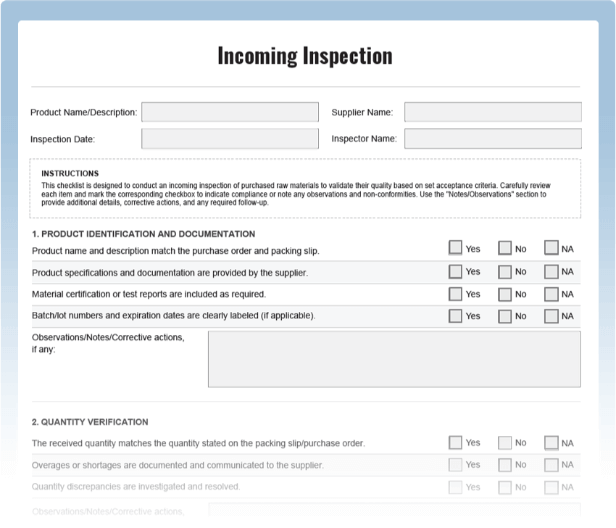
What it Ensures:
Ensures materials and equipment are inspected upon arrival at the site.
How it Can Help:
Prevents the use of defective materials and equipment, ensuring project quality and safety.
10. Take 5 Safety Inspection Checklist
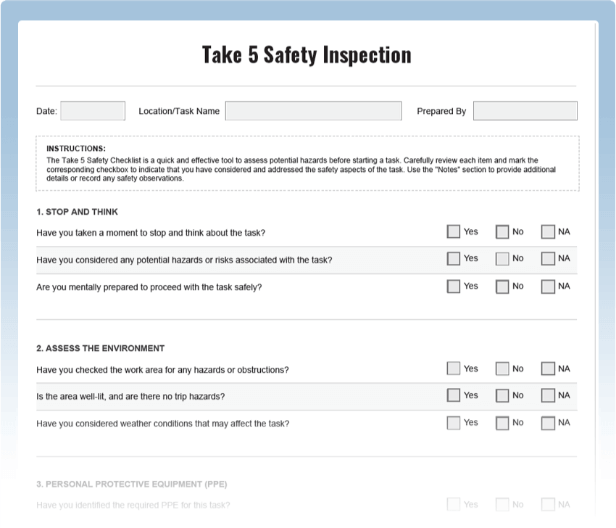
What it Ensures:
Ensures quick safety checks before starting a task.
How it Can Help:
Reduces the likelihood of accidents by encouraging workers to take a moment to assess safety before beginning work.
11. Floor Inspection Checklist
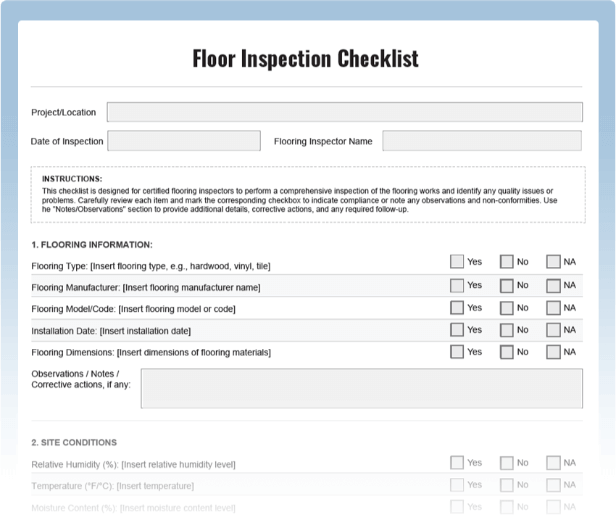
What it Ensures:
Ensures safe conditions of flooring and walking surfaces.
How it Can Help:
Prevents slips, trips, and falls by identifying and correcting floor hazards.
12. Site Safety Inspection Checklist
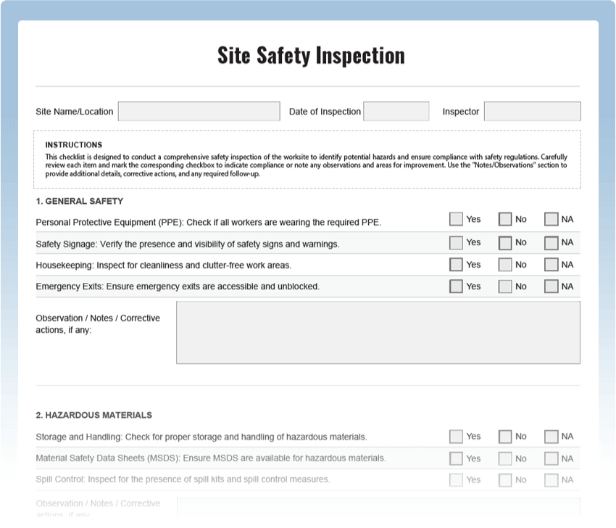
What it Ensures:
Ensures regular site-wide safety inspections.
How it Can Help:
Maintains a high level of overall site safety by addressing issues across the entire site.
13. OSHA Electrical Safety Inspection Checklist

What it Ensures:
Ensures electrical safety standards are met.
How it Can Help:
Prevents electrical hazards that can cause serious injuries or fatalities.
14. OSHA Fall Protection Inspection Checklist

What it Ensures:
Ensures compliance with fall protection measures.
How it Can Help:
Reduces the risk of fall-related injuries by ensuring proper use of fall protection systems.
15. OSHA Forklift Safety Inspection Checklist

What it Ensures:
Ensures safe operation and maintenance of forklifts.
How it Can Help:
Prevents forklift-related accidents and injuries by ensuring forklifts are in good working condition.
16. OSHA General Safety Inspection Checklist

What it Ensures:
Ensures general safety compliance checks.
How it Can Help:
Provides a broad assessment of site safety to catch potential issues early.
17. OSHA PPE Inspection Checklist

What it Ensures:
Ensures regular inspections of personal protective equipment.
How it Can Help:
Ensures PPE is effective and available when needed, reducing the risk of injuries.
18. OSHA Hazard Communication Inspection Checklist

What it Ensures:
Ensures proper communication of hazards on-site.
How it Can Help:
Helps in the effective dissemination of hazard information to all workers, enhancing safety awareness.
19. OSHA LOTO Inspection Checklist

What it Ensures:
Ensures Lockout/Tagout procedures to prevent accidental equipment startup.
How it Can Help:
Protects workers from unexpected machinery start-ups during maintenance.
20. Fire Safety Inspection Checklist
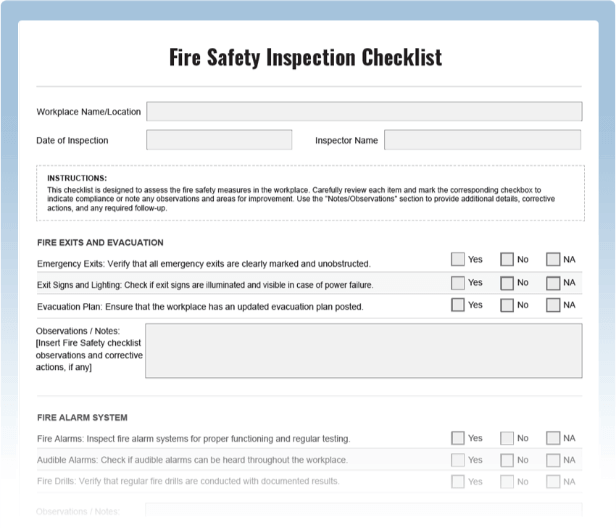
What it Ensures:
Ensures fire safety measures are in place and functional.
How it Can Help:
Prevents fire hazards by ensuring all fire safety equipment and protocols are up to date.
21. Health and Safety Inspection Checklist
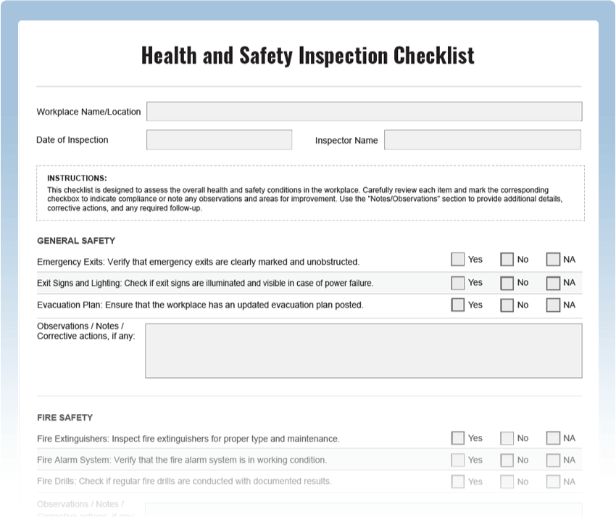
What it Ensures:
Ensures general health and safety checks.
How it Can Help:
Provides a comprehensive overview of site health and safety conditions.
22. ISO 22000 Audit Checklist

What it Ensures:
Ensures food safety management systems in construction.
How it Can Help:
Maintains high standards of food safety for construction projects involving food handling.
23. Supplier Verification Inspection Checklist
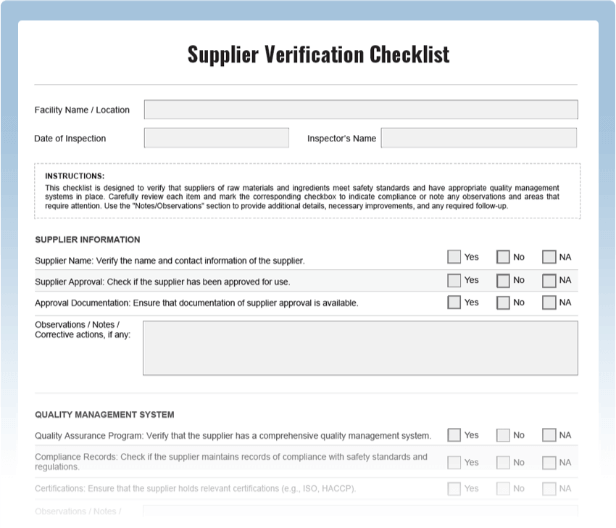
What it Ensures:
Ensures suppliers meet safety and quality standards.
How it Can Help:
Prevents issues related to substandard materials and ensures reliability.
24. Daily Safety Inspection Checklist

What it Ensures:
Ensures routine daily safety inspections.
How it Can Help:
Keeps safety practices consistent and up to date with daily oversight.
25. Ladder Inspection Checklist
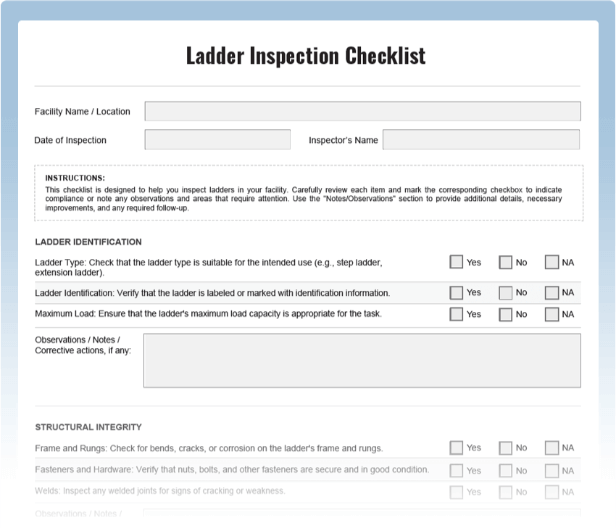
What it Ensures:
Ensures ladders are safe and in good condition.
How it Can Help:
Prevents ladder-related accidents by ensuring they are properly maintained and used correctly.
26. Risk Inspection Checklist
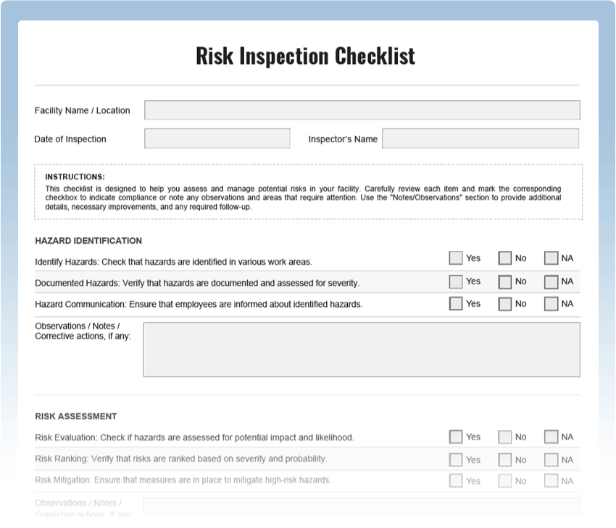
What it Ensures:
Ensures identification and assessment of risks on-site.
How it Can Help:
Helps in proactive risk management by addressing potential hazards before they cause harm.
27. Safety Audit Checklist
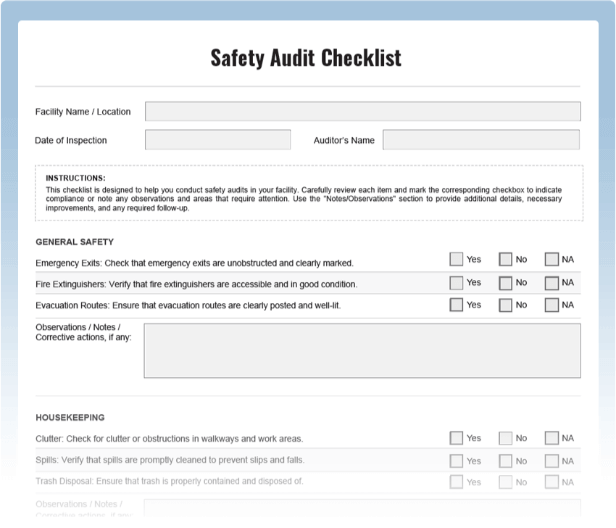
What it Ensures:
Ensures comprehensive safety audits covering all aspects of site safety.
How it Can Help:
Provides a detailed assessment of safety performance, highlighting areas for improvement.
28. Daily Report Checklist
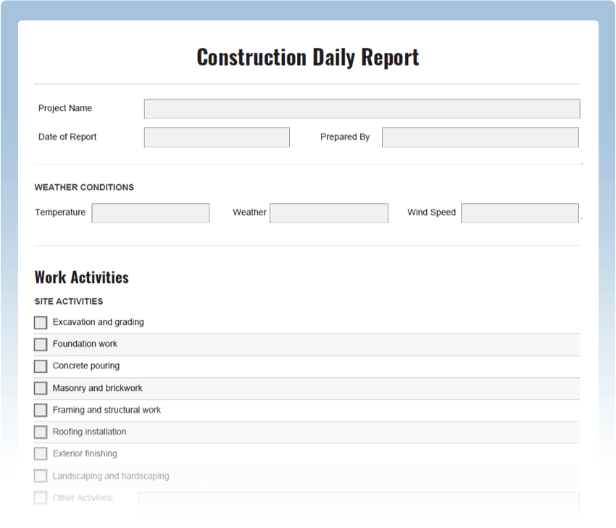
What it Ensures:
Ensures daily reporting on safety conditions and incidents.
How it Can Help:
Keeps track of safety performance and incidents on a daily basis, enabling quick responses to issues.
29. Project Closeout Checklist
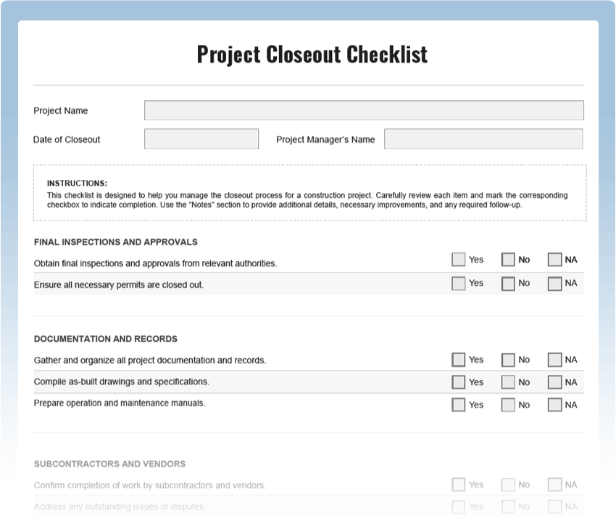
What it Ensures:
Ensures final safety checks before project completion.
How it Can Help:
Ensures all safety issues are resolved before the project is closed out.
30. Pre-Startup Safety Review (PSSR) Checklist
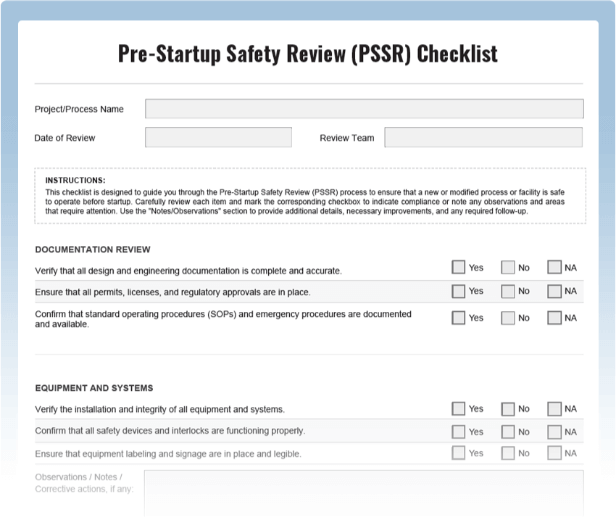
What it Ensures:
Ensures safety reviews before starting new projects or operations.
How it Can Help:
Identifies and mitigates potential safety issues before project commencement.
What Are Construction Checklists?
Construction checklists are detailed lists used to ensure that all safety and compliance aspects of a construction site are addressed. They cover everything from daily safety inspections to specific regulatory compliance checks.
Each checklist is designed to guide workers and supervisors through a series of steps to identify potential hazards, ensure safety protocols are followed, and maintain overall site safety. By using these checklists, construction teams can systematically address safety concerns and ensure a consistent approach to safety management across all projects.
Benefits of Using Construction Inspection Checklists
Using construction inspection checklists offers numerous benefits that enhance both safety and efficiency on a construction site.
First, they help in maintaining compliance with regulatory standards like OSHA, preventing costly fines and ensuring legal adherence. Checklists also streamline the inspection process, making it easier to identify and address potential hazards before they cause accidents. They promote accountability among workers and supervisors, ensuring everyone is aware of their safety responsibilities.
Additionally, construction checklists help in documenting safety measures and incidents, which is crucial for audits and continuous improvement of safety practices.
How to Use Construction Safety Checklists
Integrating construction safety checklists into your daily routine is straightforward and highly effective. Begin by identifying the specific checklists relevant to your project and distributing them to your team. Train your workers on the importance of each checklist and how to use them correctly. Regularly schedule inspections and ensure that the checklists are thoroughly completed each time. Use digital tools like Safetymint site inspection software to manage and track checklist usage, making it easier to update and share information. By consistently using these checklists, you can create a culture of safety that proactively addresses risks and enhances overall site safety.